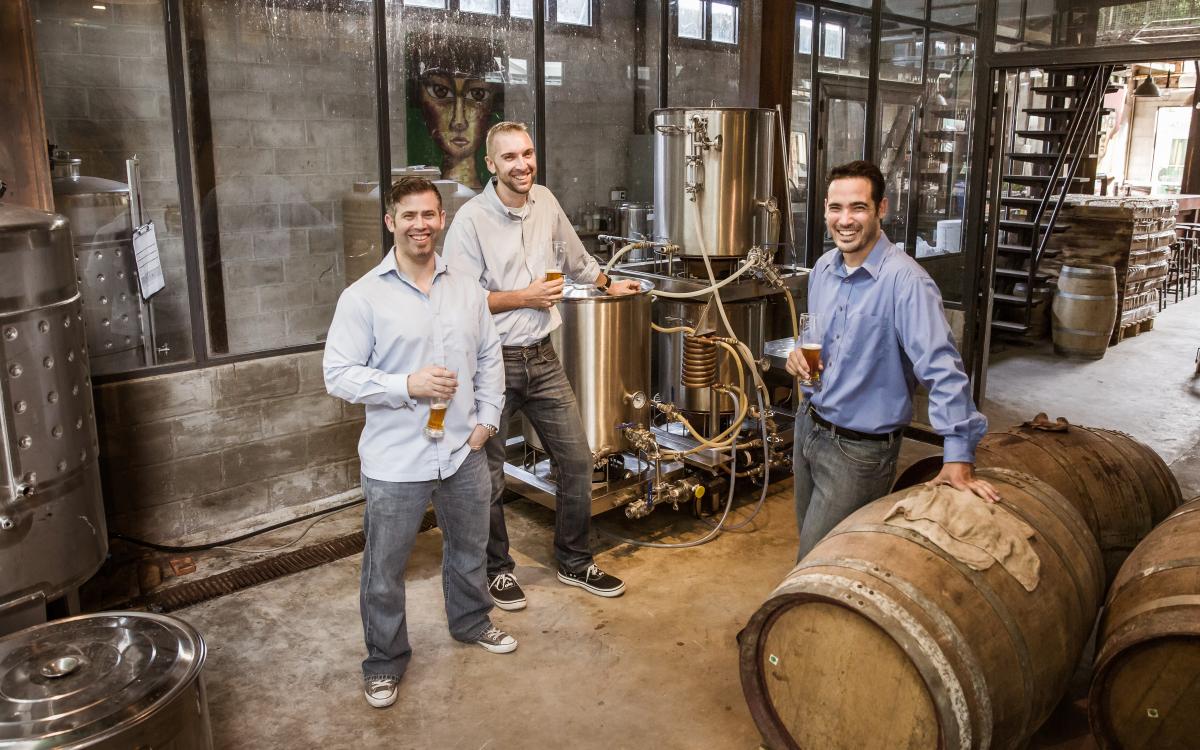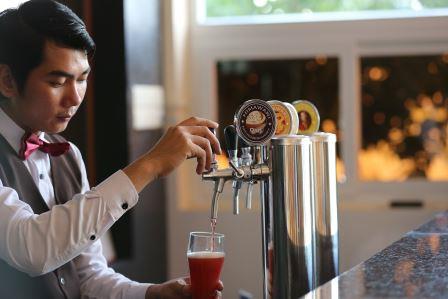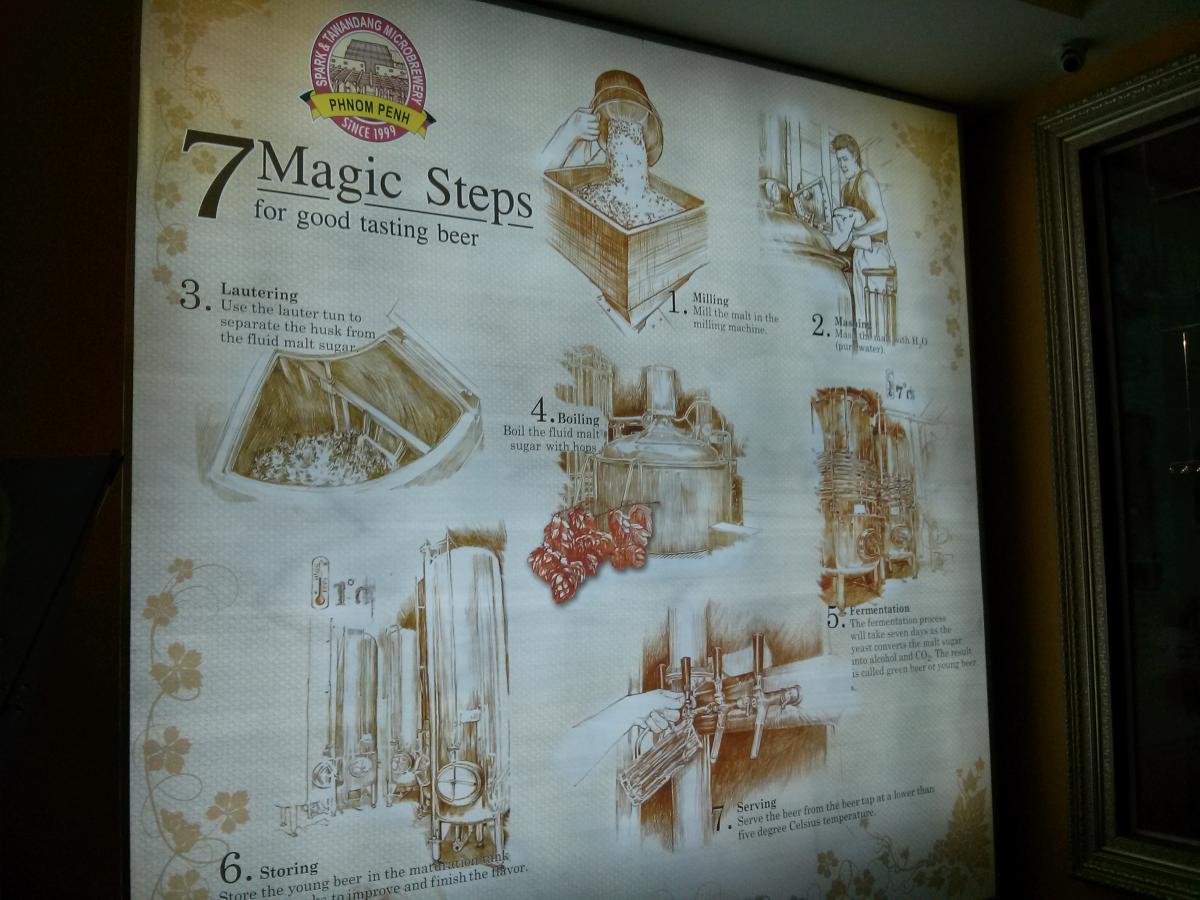“THE growing expat community in Cambodia is thirsty for what it misses from back home – a variety of good craft beer,” explains Chad Richman whose love for beer has turned him from a homebrewer to brewmaster and co-founder of Cerevisia Craft Brewhouse. “Our team has also learned in the past couple of years that there is a growing market among native Khmer for the variety, taste, and experience that good craft beer offers.”
Andrew Tay, director at Himawari Hotel Apartments and Microbrewery echoes Mr Richman’s observation. “My main customers are expats and tourists,” he says. Such client base prefers Himawari’s Gem & Jade, an English pale ale, which combines Pacific Gem & Pacific Jade hops with five different malts; its CentenniALE or American pale ale that accentuates Centennial Hops; and its OatS, a sweet stout that is low in bitterness but robust in oatmeal flavor.

Cerevisia’s team (from left) Chad Richman, Tim Ramak and Erich Phillips offers two mainstays and nine specialty and seasonal brews (Photo: Cerevisia)
Bridging ties
In a bid to forge an affiliation with the nascent local market, both Himawari and Cerevisia use materials and beer names with Khmer association.
Himawari’s Australian-Asian pale ale, for instance, is named Apsara Gold, lending reference to the traditional Khmer dance. The drink is a blend of Nelson Sauvin and Cascade. It comes with delicate malt flavor, distinct hops aroma and 5% alcohol. Its popular seasonal beer, Honey SAP, uses fresh local honey from the Tonle Sap region. It is also where the beer name was partly culled.
The honey pale ale dubbed Rattanak ESB from Cerevisia is infused with wild flower honey and farmed honey sourced from the provinces of Rattanak Kiri and Koh Kong, respectively. “The profile of the Koh Kong honey is sweet and constant, so we blend in the more erratic Rattanak Kiri varietal based on its seasonal/batch profile to help maintain consistency in our beer,” explains Mr Richman. The result: Honey dominates the nose with the sweet aroma of honeysuckles. The beer’s medium-bodied palate has an even bitterness and balances well against the caramel malt flavors and honey tones.
Himawari’s brewmaster, Neo Say Wee, whips up beer using malt from Germany and hops from the US and New Zealand. “Not all styles were rolled out when we opened in 2012,” he reveals of Himawari’s initial offerings. “We first had Nelson Blonde light ale, Gem & Jade, and Honey SAP. Later we experimented with Apsara Gold, CentinnALE and OatS, which eventually became our main features, along with Gem & Jade.”

Himawari Microbrewery’s line-up include award-winning Gem & Jade and Apsara Gold (Photo: Himawari)
Mr Neo considers “unfiltered freshness” as draft beer’s main draw. “In the beginning, people compared our craft beer with the cheaper mass-produced beer. After winning a couple of beer awards, and with the help of our marketing campaigns, customers now have a better appreciation for well-crafted beers.”
In 2013, Himawari’s Gem & Jade won Asia Beer Awards for the category of Pale/Amber Ale, while its Apsara Gold bagged the International Beer Competition for the category of Australasian /International Style Pale Ale. Its beer is mainly available from the hotel, but it sells beer at restaurant establishments that it partners with during promotions.
Brewing for the market
Only seasonally or annually does Himawari try to make a new type of beer. On two separate occasions, it tried out clients’ suggestion for a banana-flavored beer and a wheat beer. Currently, it is planning on a lager just for the Oktoberfest.
Listening to others and experimentation keep flavors flowing at Cerevisia. To date, it has two mainstays and nine specialty and seasonal brews. Its American pale ale, Centurion, is a bestseller. It has 5.6% ABV, strong citrus tones, light body, and at 38IBU, a hop forward nature. Of Cerevisia’s special edition and reserve beers, most popular is the Roman Spark, with its lightly smoked old-world ale sensation.
“We designed and built a miniature version of our brewhouse on which I can build new beers,” reveals Mr Richman. “The inspiration comes from other people--the beer they talk about, the beer they have me try, the flavors they ask for, and the food that they tell me they drink the beer with. The inspiration also comes from efforts to try and become educated through experimentation. For instance I'll find an adjunct I've never brewed with. I'll play with it in several batches to become more aware of its features--some of our best beers often come from this sort of experimentation.”
Ingredients are from a variety of international and local vendors to ensure freshness and quality. “Having a diversified supply chain makes us more resilient to supply inconsistencies and enables us to shift with the moving tides of availability. Most of our base malt comes from Europe, hops are mostly from the US, and our adjunct malts come from a variety of locales including the US and Germany. Specialty adjuncts, such as demerara or honey, are sourced locally.”
Cerevisia brews 1.3bbl-batches several days a week. “This offers flexibility to add in, or swap out one beer for another when inventory dictates,” says Mr Richman. “It also lets us program in additional batches to prepare for special events, or the silent summer season. Our fermentation capacity is about 6bbls, and we are in the process of increasing it to allow us to add more seasonal events and increase our draft reach, while still staying Craft, small, flexible, and fun.”
As it grows its business, Cerevisia helps other brewers to flourish along with it. “We’re in this for the Craft. It helps our business to teach others, aide them in sourcing supplies, and so on. It offers more Cambodians access to more variety of beer, and that in turn expands our footprint. We’ve taken the American model to craft brewing, and want to foster that environment here in Cambodia. It’s not a zero-sum game, and we can actually aide our ‘competition’ while improving our own market share.”
Cerevisia builds custom draft systems for vendors and is willing to work with any kind of set up to maintain quality control. It offers regular line cleaning (and replacement when necessary), service Co2, and regularly conducts spot checks of the venues to make sure consumers continue to get the best product it can brew. “This remains one of our more labor-intensive facets, and we love doing it because it ensures you love our beer whether you drink it at your favorite tapas restaurant, or your favorite bar.”
According to Mr Richman, the brewhouse donates spent grains to local farmers for use as feed and fertilizer. “We also only use food-grade cleaners and sanitizers that won't harm the local water supply when they are recovered, as well as no-waste containers – all of which are food-grade plastics, recycled glass, or steel. As business grows, we hope to grow our sustainability efforts at a commensurate rate.”
The purist approach
German brewers are known to be guided by “Reinheitsgebot”, or the German Beer Purity Law, which allows them to use only four ingredients –malt, hops, yeast, and water. Having received his brewmaster training from Berlin, Cambodian Ket Puthea insists on doing just that. Mr Puthea’s Five Men Microbrewery is the newest in Cambodia. Opening its first branch in Sihanoukville, southwest of the country last year, it now also distributes its pale ale and stout beer to the capital of Phnom Penh and Kampot province. Confident of rising demand, Mr Puthea is set to open another outlet in the capital this third quarter, as well as expand distribution northwest to Siem Reap.
When most craft beer are in the range of $2.50 to $6, Five Men Microbrewery’s beer can be had for as low $0.50 for a mug and about $2.30 for a bottle despite having its hop, malt and yeast imported from Germany. “It helps that I own the property where the microbrewery stands so I don’t have to pay rent. And because I brew the beer myself, I don’t have to spend on wages.”Mr Puthea is mentoring his own son in beer brewing, having been mentored himself at leading commercial breweries where he worked for 16 years.

Twin brew kettles and a visual wall at Spark & Tawandang Microbrewery’s entrance acquaint clients of its in-house brewing process
Asia’s old-timer
Tawandang Microbrewery has been in Asia since 1999. It first set up shop in Thailand, where it now has three branches. It then joined the bustling craft beer scene in Singapore and in March 2014, made Cambodia its latest base. As with its other locations, the Phnom Penh branch serves beer in half- to 1-liter glasses and long towers of 2 to 3 liters. A glass locally fetches for $2.50, while a tower at $20. Both are slashed to half price during promotions.
Its Weizen beer is popular among Europeans customers. Fermented for 19 days and made from malted barley, banana or mango and aromatic hops, it has a lovely fruity fragrance, foamy texture and 5.5% alcohol content.
The White Lager features an attractive golden color, a pleasant hoppy aroma and a mild flavor. The all-time favorite especially among Japanese and Chinese clients has a fermentation period of 28 days and contains 5% alcohol.
The Dunkel beer has the least amount of alcohol of the microbrewery’s offering at 4.5 %. It comes with a sweet taste and tantalizing scent of roasted malt.
“Demand is growing,” says branch manager Sen Sinat, “because customers are realizing that fresh beer is better for their health and it tastes better too.”
Sales are confined to the microbrewery’s premises. Mr Sinat explains that the nightly live concerts and dance shows are what attract the crowd, who discover its beer in the process. The push to acquaint clients starts at the very entrance of the microbrewery where large twin copper brew kettles are seen behind a glass display window. Alongside them is a graphic representation of the in-house process of making great-tasting beer. In between lively performances at its massive dining hall, a video detailing the brewing process is shown.
Nike Ambassador VIII 8
 iConnectHub
iConnectHub
 Login/Register
Login/Register Supplier Login
Supplier Login



























